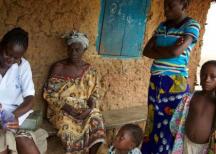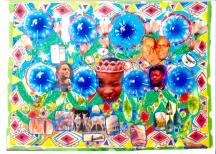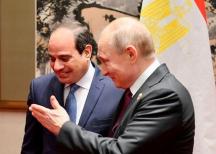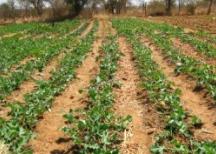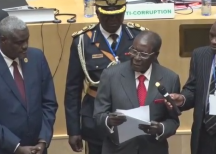
Reflecting on the availability of documentary sources, Herbert Ekwe-Ekwe discusses the history of the Igbo genocide.
Thankfully, for the interest of posterity, the Igbo genocide, perpetrated by the Nigeria state, is one of the most documented crimes against humanity. Leading university and public libraries across Europe (particularly in Britain, Ireland, France, the Netherlands, Germany, Switzerland, Italy, Portugal, Denmark and Sweden) and North America have invaluable repositories of books, state papers (including, crucially, hitherto classified material now declassified as part of mandatory timeframe provisions and freedom-to-information legislations), church papers, human rights/anti-genocide/anti-war groups’ campaign papers, reports, photographs and interviews, Red Cross/other third sector papers, reports and photographs, newspaper/news magazine/radio/ television/video archives and sole individual depositories, some of which are classified as ‘anonymous contributors’.
These data variously include extensive coverage of news and analyses of varying features of the genocide between May 1966 and January 1970, as well as still photographs and reels and reels of film footage of the devastating impact of the genocidists’ ‘starvation weapon’ attack on Igbo children and older people, the genocidist air force’s carpet bombings of Igbo population centres (especially refugee establishments, churches, shrines, schools, hospitals, markets, homes, farmlands and playgrounds) and the haunting photographs and associated material that captures the sheer savagery of the slaughter of 100,000 Igbo in north Nigeria towns and villages and elsewhere in parts of west Nigeria (especially Lagos and its suburbs, Ibadan, Abeokuta, Oyo, Benin) during the first phase of the genocide in May to October 1966.
A stream of these archival references has flowed steadily onto the YouTube website, as well as other internet outlets, and much more material on the genocide will be available online in the months and years ahead. On the whole, these documentations are a treasure trove for the conscientious scholar and researcher of the genocide. For the would-be prosecutor of the perpetrators of this crime, they couldn’t have wished anything more for that crucial resource base to embark on their historic enterprise. A total of 3.1 million Igbo, or a quarter of the nation’s population at the time, were murdered in the genocide, the worst in Africa since the 19th century. On the morrow of 44 months of unrelenting slaughtering, Nigeria, the perpetrator, emerges as the undisputed obligatory haematophagous monster in this south-west-central region of Africa. Its death march on the Igbo and Igboland was soon relayed, tragically, across the continent – Uganda, the Congos, Somalia, Rwanda, Burundi, Sierra Leone, Liberia, Côte d’Ivoire, Darfur … resulting in the murder of an additional 12 million Africans in the subsequent 40 years.
NOT-YAKI
Quite auspiciously, the record of those who ordered/executed the Igbo genocide makes no pretences, offers no excuses, whatsoever, about the goal of their dreadful mission – such was the maniacal insouciance and rabid Igbophobia that propelled the project. The principal language used in the prosecution of the genocide was Hausa. Appropriately, the words of the ghoulish anthem of the genocide, published and broadcast on Kaduna radio and television throughout the duration of the crime, are in Hausa: ‘Mu je mu kashe nyamiri/Mu kashe maza su da yan maza su/Mu chi mata su da yan mata su/Mu kwashe kaya su’ (‘Let’s go kill the damned Igbo/Kill off their men and boys/Rape their wives and daughters/Cart off their property’).
The Hausa word for war is yaki. Whilst Hausa speakers would employ this word to refer to the involvement/combat services of their grandfathers, fathers, uncles, sons, brothers, other relatives and friends in ‘Boma’ (reference to Second World War Burma [contemporary Myanmar] military campaigns/others in south-east Asia, fighting for the British against the Japanese) or even in the post-1960s Africa-based ‘peace-keeping’ military engagements in Cameroon, the Democratic Republic of Congo, East Africa, Liberia, Sierra Leone and Sudan, they rarely use yaki to describe the 29 May 1966 – 12 January 1970 mass murder of Igbo people. In Hausaspeak, the latter is either referred to as ‘lokochi mu kashe nyamiri’ (‘when we murdered the damned Igbo’) or ‘lokochi muna kashe nyamiri’ (‘when we were murdering the damned Igbo’). Pointedly, this ‘lokochi’ (when, time) conflates the timeframes that encapsulate the two phases of the genocide (29 May 1966 – 29 October 1967 and 6 July 1967 – 12 January 1970), a reminder, if one is required, for those who bizarrely, if not mischievously, wish to break this organic link.
Elsewhere, genocidist documentation on this crime is equally malevolent and brazenly vulgar. A study of the genocide-time/‘post’-genocide era interviews, comments, broadcasts and writings on the campaign by key genocidist commanders, commandants and ‘theorists’ and propagandists such as Benjamin Adekunle, Yakubu Danjuma, Yakubu Gowon, Olusegun Obasanjo, Hassan Katsina, Ibrahim Haruna, Oluwole Rotimi, Obafemi Awolowo, Anthony Enaharo and Allison Ayida underscores the trend. A brief review of Obasanjo’s contribution (published in his memoirs, My Command) that focuses on his May 1969 direct orders to his air force to destroy an international Red Cross aircraft, carrying relief supplies to the encircled and blockaded Igbo, is crucially appropriate.
Obasanjo had ‘challenged’, to quote his words, Captain Gbadomosi King (genocidist air force pilot), whom he had known since 1966, to ‘produce results’ in stopping further international relief flight deliveries to the Igbo. Within a week of his infamous challenge, 5 June 1969, Obasanjo recalls nostalgically, Gbadomosi King ‘redeemed his promise’. Gbadomosi King had shot down a clearly marked, incoming relief-bearing International Committee of the Red Cross (ICRC) DC-7 plane near Eket, south Biafra, with the loss of its 3-person crew.
Obasanjo’s perverse satisfaction over the aftermath of this horrendous crime is fiendish, chillingly revolting. He writes: ‘The effect of [this] singular achievement of the Air Force especially on 3 Marine Commando Division [the notorious unit Obasanjo, who later becomes Nigeria’s head of regime for 11 years, commanded] was profound. It raised morale of all service personnel, especially of the Air Force detachment concerned and the troops they supported in [my] 3 Marine Commando Division.’
Yet despite the huffing and puffing, the raving commanding brute is essentially a coward who lacks the courage to face up to a world totally outraged by his gruesome crime. Instead, Obasanjo, the quintessential Caliban, cringes into a stupor and beacons to his Prospero, British Prime Minister Harold Wilson (as he, Obansanjo, indeed unashamedly acknowledges in his My Command) to ‘sort out’ the raging international outcry generated by the destruction of the ICRC plane…
BROUGHT TO YOU BY PAMBAZUKA NEWS
* Herbert Ekwe-Ekwe is an independent scholar on inclusive state systems and the rights of constituent peoples. His new book ‘Readings from Reading: Essays on African Politics, Genocide, Literature’ will be published later in 2011.
* Please send comments to [email protected] or comment online at Pambazuka News.
- Log in to post comments
- 1620 reads

